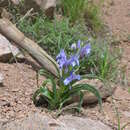en
names in breadcrumbs


Iris graeberiana is a species in the genus Iris, in the subgenus of Scorpiris. It is a bulbous perennial.
In late spring,[2] (or April),[3] it has between 4–6 flowers per stem and reaches a maximum height of 45 cm (18 in) tall.[4]
It has pale silvery mauve flowers.[4] It also comes in blueish-lavender,[2] or blue-violet shades.[5] The flowers are 6–8 cm (2–3 in) wide with a wavy,[5] white crest on each fall.[2] Which is surrounded by a pale, boldly veined zone.[5]
The white margined leaves, have glossy mid-green tops, but with greyish green bottoms, which are scattered along the stem.[2] The leaves grow to approximately 20 cm (8 in) tall at flowering time, then they extend to twice this. They are between 1.5–3.5 cm (1–1 in) wide.[5]
It was named after Paul Graeber (a plant collector who also collected Iris hoogiana and Tulipa ostrowskiana for the Dutch Van Tubergen company).[6][7]
It was first published in Botanical Magazine Vol.167 on table 126 by Sealy in 1950.[8]
Iris graeberiana is an accepted name by the RHS,[9] and the iris is recognized by the United States Department of Agriculture and the Agricultural Research Service, since 2003.[10]
It is native to Tajikistan,[11] and Turkestan (parts of the former republic of USSR) in Central Asia.[4]
It is known as one of the more vigorous species,[4] therefore is easier to grow the others in the subgenus.[2] It is also hardy to USDA Zone 5–8.[12]
They are best grown in well-drained soils [13] in open, stony places or an Alpine house, but some growers recommend outside culture, if sheltered from heavy summer rains.[5] The plant attracts birds and butterflies.[14]
It can be seen growing in Le Grand Clos botanical garden in Bourgueil, France.[15]
It is thought to have been bred by crossing Iris graeberiana with Iris magnifica.[12]
Iris graeberiana is a species in the genus Iris, in the subgenus of Scorpiris. It is a bulbous perennial.